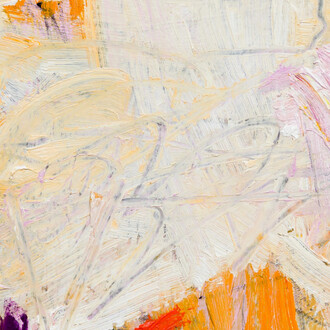Marking thirty years since his first solo exhibition at Flowers Gallery, former official British War Artist John Keane presents a new series of paintings on the themes of power and conflict.
Keane’s work has been engaged in a dialogue with unfolding news stories since the 1980s, travelling overseas to witness conflicts first hand. His work challenges received wisdom and explores alternative narratives to those exerted by the press - from his representation of the atrocities of war, to his portraits of the people made powerful by their place in and behind the media spotlight.
In his latest exhibition, Keane turns on its head the popular cliché ‘speaking truth to power’ to invite reflection upon a fundamental question of agency: does the artist have the ability to affect change? He says: “A free society places considerable importance on the contribution of artists and independent thinkers in upholding its freedoms and questioning its values, but how much influence does this really exert?”
The subjects of his latest portraits include Rupert Murdoch and Rebekah Brooks (both of whom were painted from media imagery during the Leveson Inquiry) and Vladimir Putin.
The appropriated images are reproduced in oil on linen. Keane introduces gestural drips, smears and stains - at times dragging the paint with a squeegee, leaving the evidence of its material substance on the surface in congealed mounds.
Described by the artist as a “process of obscuring and obfuscation”, his painterly mediation and abstraction of the image implies new meanings. In Red Square, a smear of red paint shielding Putin’s face is both an allusion to Soviet and Czarist history and a nod to Malevich. His subjects are distorted by various methods; areas are blurred, refined to the patterns of digital pixels, or viewed through a screens of dots, recalling the Ben-Day printing process.
This abstraction takes a new direction in The Distillation of Terror in which Keane responds to imagery of recent desert beheadings in the Middle East by reducing the image to a formal arrangement of orange and black pixels. He says: “I wanted to address the sinister theatricality of the imagery without including gruesome or voyeuristic viscera. Transforming the specific into the archetypal allowed me to engage with the picture more, not less.”
Brian Eno, in an introduction to a new publication produced alongside the exhibition, describes Keane’s works as having an “ominous charge”. He says: “They don’t feel like pictures about the scenes that they show; instead they seem to come right out of those scenes, as if they were there as it was happening.”
The rare inclusion of a self-portrait in this exhibition represents the artist as a witness, signalling his own assertion of authority - while admitting elements of self-doubt and uncertainty, by putting himself under scrutiny. Although the title of the exhibition may question the power of the artist to change the world, Keane’s paintings, which exert a force of their own, make an attempt to redress the balance.
The exhibition coincides with a survey of works by Keane:The Wisdom of Hindsight at Flowers Gallery, Kingsland Road, May 20- June 27.



















